Kei Tua o te Pae
Kei Tua o te Pae/Assessment for Learning: Early Childhood Exemplars is a best-practice guide that will help teachers continue to improve the quality of their teaching.
The exemplars are a series of books that will help teachers to understand and strengthen children's learning. It also shows how children, parents and whānau can contribute to this assessment and ongoing learning.
We are making improvements to our download-to-print functionality. So if you want a printed copy there are PDF versions available at the bottom of the main cover page.
Exemplars – Ngā tauaromahi
-
Adam determines the routine
-
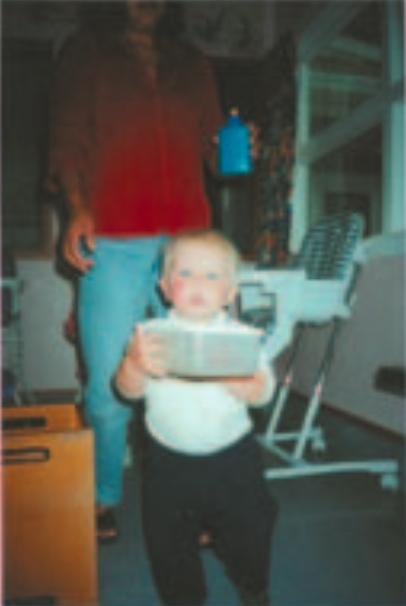
March
Adam is so familiar with all the routines in the centre. He is seen here helping Bing to put his lunchbox away after morning tea. Adam enjoys sitting at the morning tea table and likes to start off the session with his morning tea at present. His mother says he is getting fussy with breakfast.
18 March
Teacher: Jo
Adam is getting very independent. This morning when he arrived at pre-school, his mum handed him his lunchbox when they got in the door and asked Adam to put it away in the drawer where we keep the children’s lunchboxes. Adam held his lunchbox in front of him and walked across the room to the bench. He opened the drawer and put his lunchbox in it then shut the drawer and went to play.
2 April
Teacher: Jo
Adam is communicating his needs to us very clearly at the moment. This morning, Adam once again arrived in the nursery holding his lunchbox, but instead of putting it away, Adam placed it on the table. He then walked across to where the table covers hang and started to pull the purple one that we use for kai time down. I got the cover down for Adam and put it on the table. Adam went and stood by the basin, so I turned the tap on, and he washed his hands. Adam then went and sat down at the table and had something to eat to start the day.
This story is also a nice example of how familiar Adam is with the centre routines that surround kai time.
23 May
Teacher: Jo

For a while now, Adam will sit down at the table to eat some of his food when he first arrives in the morning. He stops when he has had enough and is happy to go off and play.
-
-
James pursues a friendship
-
Child's name: James, 9 months, 3 weeks
Date: 8 Oct
Observer: Julie
A learning story
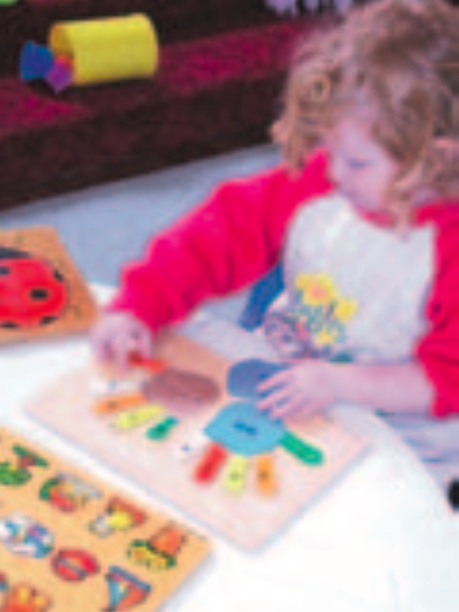
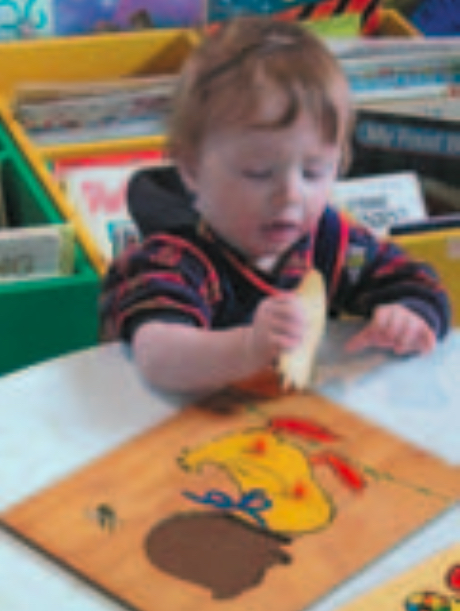
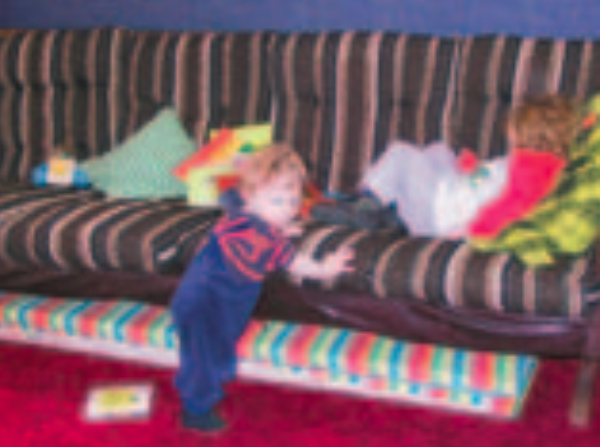
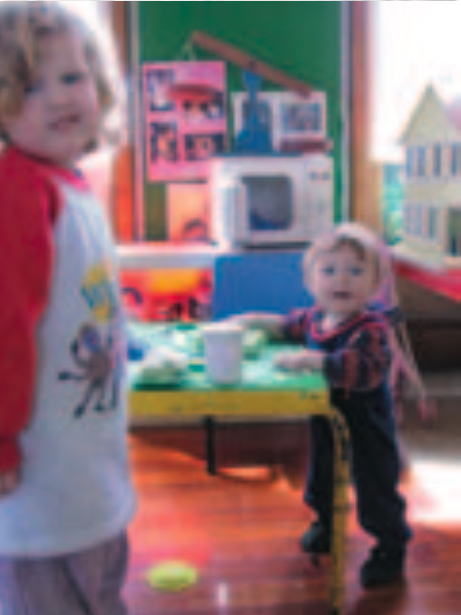
James crawls to the puzzle area where Leigh (3.5 years) is completing a puzzle. He looks at what Leigh is doing, then chooses a puzzle and starts to work with it. He takes a piece out and attempts to put it back in. He tries quite a few times to position the piece correctly by lifting it out, repositioning it, and putting it back in. Eventually, the piece goes in the right way.
Leigh (the older child) finishes her puzzle, looks around for something to do, then yawns and goes to lie down on the sofa. James crawls across the floor and up the steps, and crawls to the sofa and stands near Leigh.
Leigh doesn't respond, so James crawls towards some books and looks at them.
When Leigh later moves to the playground area, James follows her, and they play together there for ten minutes or so.
Short-term review
James is enjoying being able to move independently and chooses his own activities and company.
Although he and Leigh are unable to communicate verbally, it is clear he wants to be in her company.
James is enjoying exploring the playcentre and particularly likes puzzles, books, and playdough.
(Leigh makes no attempts to discourage him, and the two children finally play together.)
What next?
Encourage James to play alongside other children.
Let him experience different types of puzzles, different textures (playdough, finger paint, sand, clay & water play), read him short stories and picture books.
James also enjoys music, particularly the drum and the small shakers. This might be an opportunity for further play with other children.
-
-
Ruby and the supermarket
-
Learning story
9 June Teacher: Sue
Several children were busy in the sandpit, making puddings. Ruby was very sure of exactly the ingredients she needed for her pie – “Bananas, apples, chocolate, ice cream” – but she indicated that she didn’t have them all. “Perhaps we could go shopping?” I suggested.
So we set off. First we went to the “fruit shop”. “Need two apples,” said Ruby. We found the “apples” and handed over the money. Ruby had a bucket with a little bit of sand, and each time she bought something, she fished in the bucket and handed over some “money”. “What else does Ruby need?” “Get some bananas.” She used a lot of language.
The game went on for some time. (The others left us for different activities.) We visited a different shop for the ice cream and chocolate and then another one for a handle for the door and some screws. (On our travels, Ruby noticed the door of the sleep room and announced that we needed “a handle and some screws”.)
We made our way back to the sandpit to make the pie after our busy shopping trip.
Learning story
9 June, again Teacher: Jo
Today, just like every other day, Ruby amazed me with her articulate nature. I observed Ruby and Sue discussing a trip to the shops and was very keen to pay attention as these imaginative interactions with Ruby are often so filled with rich language and with scientific and mathematical concepts. They’re a real joy to watch, even when you’re not taking part!
Apples and kiwifruit were on the agenda today. Today, Ruby’s plan was for a short visit, with just enough time to get two shiny red apples and two brown kiwifruit. “All finished now,” said Ruby once she had made her purchases.
Seeing my opportunity, I approached. “Would you like to draw a picture of your shops and food, Ruby?” “Okay,” said Ruby, running over to the table. “Apple,” she said as she drew circles on her paper in red crayon. “Is this the colour of your apples, Ruby?” I asked. “Yes,” said Ruby. “Red.” “Well done, Ruby. What else did you buy?”
“Kiwifruit – look, there” she said, pointing to her picture. Before long, we had drawn the shops as well as some pictures of her mum and dad.

Ducking inside for a moment, I brought out an apple that had been cut in half. Showing it to Ruby, I explained how
the apple had been cut and asked whether she would like to draw a picture of the inside of the apple. “No, peel it,” was the response. “Why?” I asked. “So Ruby eat it,” was the delightful answer I received as Ruby began chewing away on the apple! Well, I never!What learning happened here?
Ruby’s thirst for knowledge is very much an aspect of her personality. Her make-believe play provides an information exchange within a responsive social context. Ruby’s use of language in her play as she responds, imagines, questions, describes, creates, and decides shows her independence, confidence, and sense of responsibility for her own learning.
Her awareness of scientific and mathematical concepts was evident as she talked about colours and numbers and explored past events.
What next?
Well, a trip to the shops with Ruby is a must. My interest couldn’t be greater. Is she wonderfully helpful? Does she enjoy gathering groceries? I’m sure I will soon see. Keep a lookout for Ruby’s follow-up story, soon to come – a visit to the real shops!
"Children’s learning is greatly influenced by the role of the family and significant others. The attitudes, skills and knowledge developed in the early years are the basis for learning in later years."
Hogben and Wasley, 1989, page 22
The supermarket
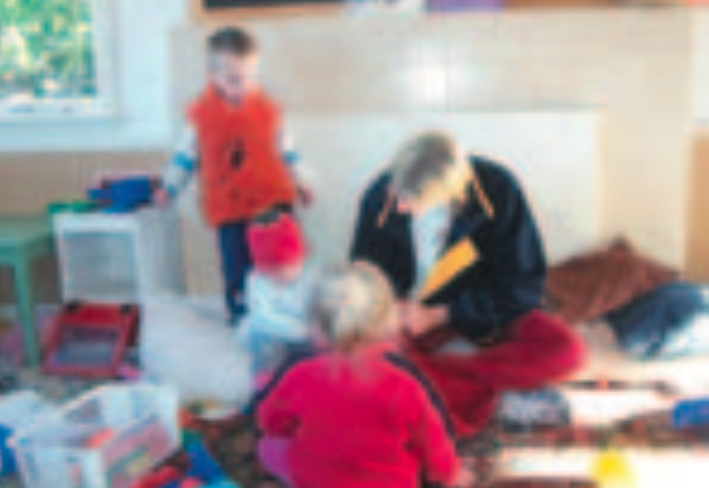
12 June Teacher: Jo
“Read Ruby’s stories,” said Ruby on spotting me early this morning.
And so the much anticipated supermarket adventure began. After hearing and seeing her latest story, Ruby showed a keen interest in this shopping trip to the supermarket. She gobbled up an explanation of the need for a “shopping list” of things to buy, and then we settled to the task at hand.

“Crackers, bananas, and a paper” were “musts” for Ruby. Mille was a keen helper, happy to help budget as long as she could join us in the adventure. Checking the usually forbidden kitchen cupboards was an amusing task, which they followed by asking all the teachers for further suggestions. “Shopping list,” they announced proudly, waving it around.
This time- consuming challenge was of huge interest to these shoppers, who giggled a lot. “Panadol,” suggested Lorraine, holding her head! (Ha, ha.) “Shelley,” said Ruby, so we went in search of Shelley. “Bubbles” was Shelley’s shopping item of choice, and so the journey continued.
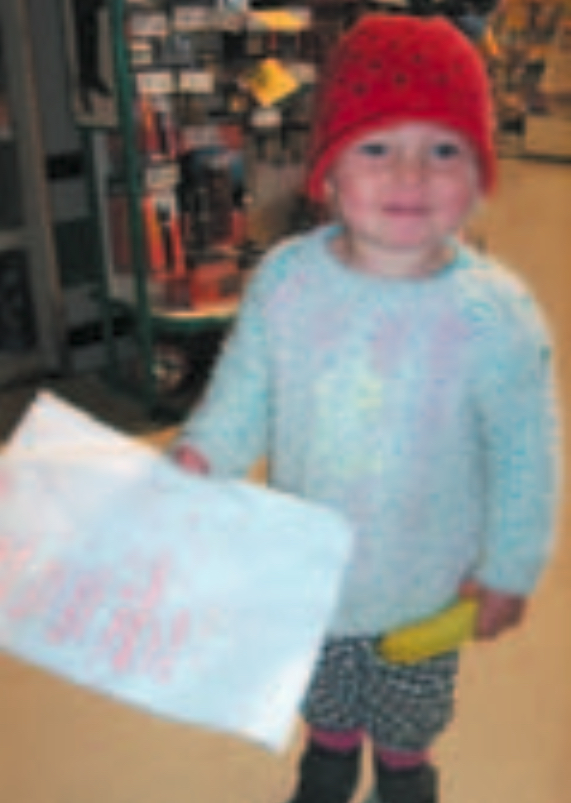
With our list in hand and warm hats on, we set off with excitement at an all-time high and delightful smiles shining from our faces.
The walk was not without challenge as I managed to get the double pushchair stuck in the supermarket entrance bars. After holding up a lot of busy shoppers, we got through and were off again.
What a hoot!

Once inside, the fun really began as we searched the aisles for the items on our list, then placed them in the pushchair, a very tricky task when holding a banana. But what clever helpers! With all our items in hand, we paid, waved, and left the supermarket, keen to return another day.
Munching on our bananas, we returned to the centre, put our shopping away, and sat down for a rest and chat. “What did you think about our trip to the shops, Ruby and Mille?” I asked. “Fun shopping!” said Ruby. “Shops, yeah.
Walk,” replied Mille. An all-round success, I would say.
What learning happened here?
Reading her learning story and looking at photographs of herself gave Ruby the opportunity to revisit her learning and interests. It also cemented her feelings of confidence and independence and her awareness of how much we value what she does. Our discussing going on a trip to the supermarket enabled Ruby to take responsibility for her learning and to express her ideas and feelings, two very significant learning dispositions. As I had suspected, Ruby was wonderfully helpful on the trip. She persisted with the difficulty of lifting heavy items and gained enjoyment from leading this learning opportunity.
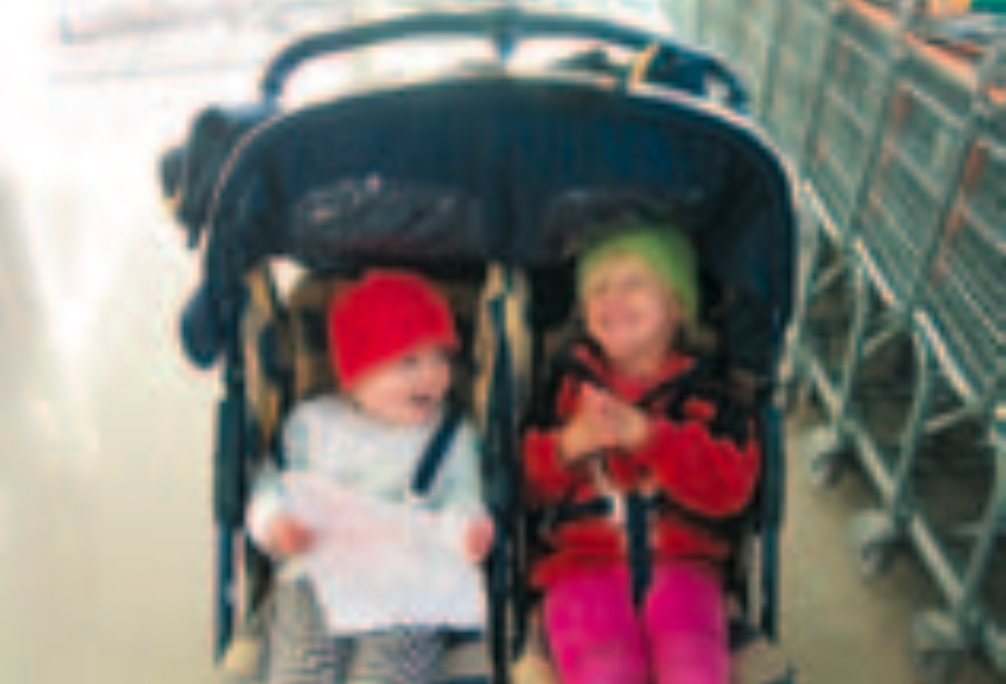
What next?
We will offer Ruby more opportunities to explore her interests and extend already cemented learning.
-
-
Copy cats
-
Child’s name: Ngaio and Izak
Date: 6 October
Teacher: Ginny
Examples or cues A Learning Story
Belonging
Mana whenuaTaking an Interest Finding an interest here – a topic, an activity, a role. Recognising the familiar, enjoying the unfamiliar. Coping with change. Izak came over to play from the Over 2's. Ngaio was watching him as he went inside and picked up a play phone from the toy shelves. Ngaio followed him and found a phone of her own. When Izak went outside, so did Ngaio. They sat and explored the phones together. Ngaio placed the receiver to her ear while pressing the buttons. Izak was busy doing the same. When Izak moved away, holding the receiver and letting the phone drag along the ground, Ngaio followed, dragging her phone, too.
After a while, Ngaio decided to try something new with the phone. She placed the cord part around the back of her shoulders so the phone dangled above the ground. Izak liked the look of this and had a go with his phone.
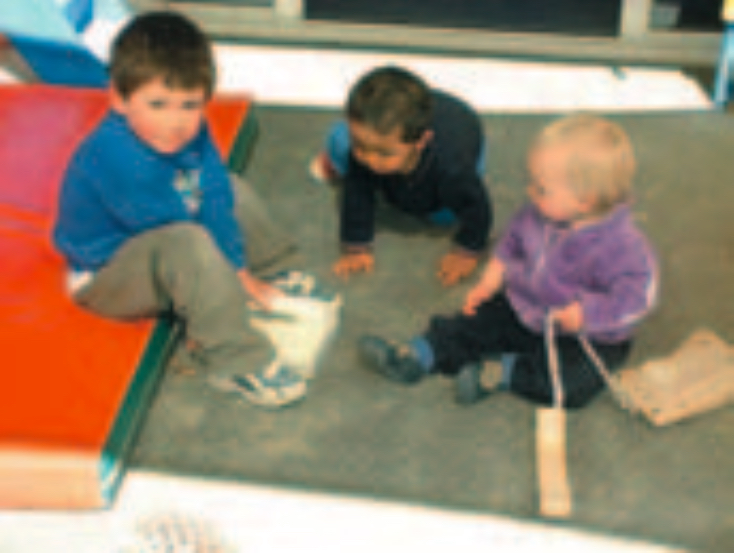
Well-being
Mana atuaBeing Involved Paying attention for a sustained period, feeling safe, trusting others. Being playful with others and/or materials. Exploration
Mana aotūroaPersisting with Difficulty Setting and choosing difficult tasks. Using a range of strategies to solve problems when ‘stuck’ (be specific). Communication
Mana reoExpressing an Idea or a Feeling In a range of ways (specify). For example: oral language, gesture, music, art, writing, using numbers and patterns, telling stories. Contribution
Mana tangataTaking Responsibility Responding to others, to stories, and imagined events, ensuring that things are fair, self-evaluating, helping others, contributing to programme. Short-term review
To me this learning story was a lovely example of how younger and older children can enjoy playing with and alongside each other. Ngaio saw Izak as someone to imitate and chose to follow what he did. Later this role changes to where Ngaio influenced the direction of Izak's play. They both demonstrated a sense of being comfortable with each other's company throughout their play.
“Children experience an environment where they are encouraged to learn with and alongside others.”
Contribution, Goal 3 Te Whāriki – Early Childhood Curriculum, page 70.
What next?
We will:
- continue to encourage older children to visit and play with our Under Two's children;
- provide sufficient playthings for children of differing ages to play with alongside each other;
- support Ngaio's attempts at initiating social interactions with the older children.
-
-
Jayden's towers
-
Learning story
July

Jayden likes to put things back in their place. Today, the children took the car-racing track out of its box and played with it for a short time. Jayden was then keen to put it back, persevering with the task.


Learning story
19 September Teacher: Jill
Jayden was very involved with threading the cotton reels when we got them down today. I showed him how to thread the cord through the beads. Jayden sat there and tried to copy what I had shown him. After twenty minutes of focused time, Jayden had threaded eleven reels and was able to cope quite easily.

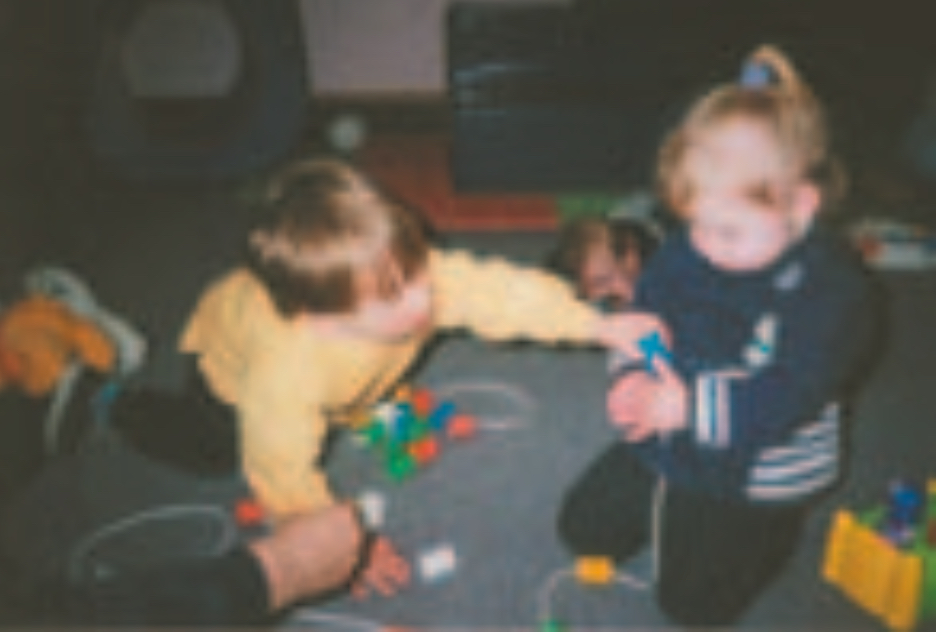
Interpretation/analysis
Jayden enjoyed the challenge, learning initially through imitation. He had a feeling of success – learning a new skill. He experienced one-to-one correspondence as well as quantity and number. (Eleven beads!) He was working on how things fit together. He was experiencing the concept of “more”. Jayden became involved and persevered with this difficult task.
What next?
Jayden can make good use of the materials in our room. He spends time sorting and classifying. We can give him more equipment, such as open play material and linkage toys.
Learning story
November
Teacher: Wendy
Jayden was fitting together a small construction set at the table when it got too high. He stood up ... but it got too high again. He stretched up and jumped, trying to fit another bit on. I nudged a chair towards him, and he climbed on and continued until it again got too high. Again he jumped, really trying to get a bit on top. I put the construction on the floor, and he was able to fit all the bits on. He was very happy with this.
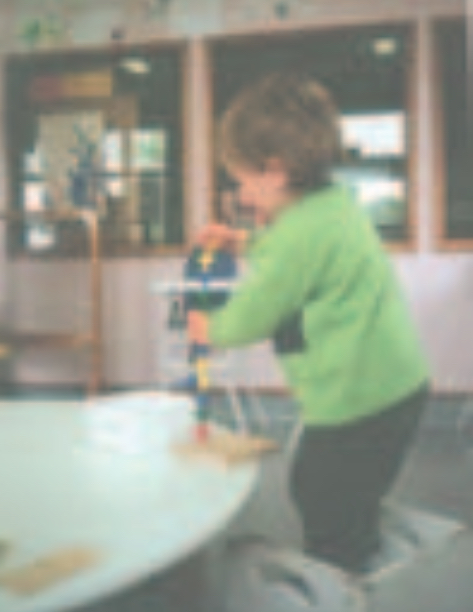

Interpretation/analysis
This activity has given Jayden the experiences of:
- being involved, paying attention for a sustained period of time;
- the concepts of space and height;
- problem solving.
What next?
We will give him the set again and see if he can get all the bits together without help.
Learning story
April Teacher: Jill
A group of children were playing with the animal train pieces. Jayden watched them making trains and started putting an engine and carriage together. He looked for an animal piece to put in the carriage. He tried two or three, but they didn’t fit in. Finally, he found one that fitted. “It’s the same colour as the carriage,” I said. He put on another carriage, looked for another animal piece, and found a piece that matched his carriage. “It’s green,” he said and, pointing with his finger, said, “One, two”. He put some more carriages on and counted again, “One, two, one, two”, and then he pushed the train along the floor, making a train noise.
Short-term review
Jayden is matching colours and knows the names of “1” and “2”. He is taking cues from other children when playing alongside them and is interested in counting.
What next?
We will provide colour-matching activities and encourage counting with the materials he chooses to play with.

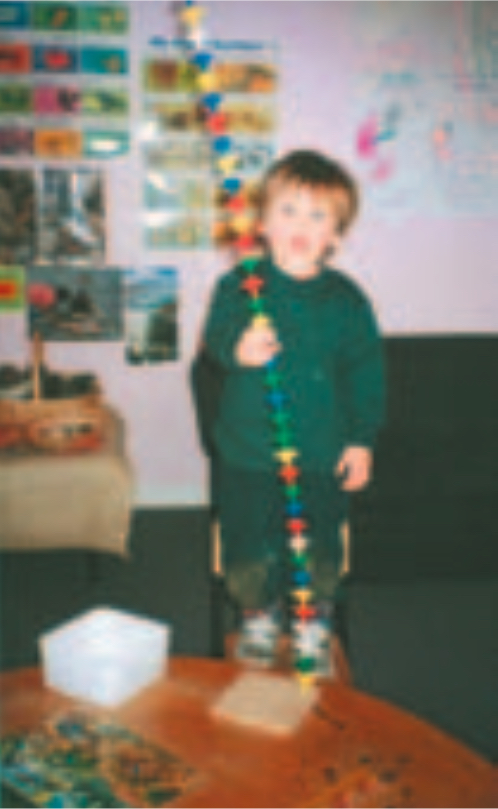

What’s happening here?
Jayden likes to sort, put things away, and put things together. He helps the teachers and other children to do this a lot, sometimes showing others what to do. Jayden’s interest in putting things together is extended when he is introduced to a connecting construction set.
What aspects of assessment for infants and toddlers does this exemplify?
These assessments become more detailed over time as the teachers recognise the significance of Jayden’s learning through his interests.
The assessments also document the development of Jayden’s problem-solving skills. In one story, he uses the pieces of the construction set to build a tower, but he has a problem when he can no longer reach the top of the tower to add more pieces. A teacher suggests a chair, and Jayden finds this to be a satisfactory means of accomplishing the goal he has set himself. Another assessment describes how Jayden revisits this experience several months later, this time automatically getting a chair when he can no longer reach the top and going on to use another strategy when again he can no longer add pieces to his tower.
How might this assessment contribute to infants’ and toddlers’ learning?
The teachers here note a variety of events over time. Gradually these form a picture of Jayden’s interests and attention to tasks that require a certain degree of persistence and understanding of spatial relationships. The teachers recognise the relationship between these events and respond to this learning in both spontaneous and planned ways.
What might this tell us about informal noticing, recognising, and responding in this place?
Assessments in this setting are sited within infants’ and toddlers’ interests and enthusiasms. Some of the assessments reflect the sometimes subtle nature of infant and toddler learning, which the teachers could miss if they weren’t perceptive observers.
-
-
Double-ups
Child’s name: Erica
Date: 3 September
Teacher: Ginny
Examples or cues A Learning Story
Belonging
Mana whenuaTaking an Interest Finding an interest here – a topic, an activity, a role. Recognising the familiar, enjoying the unfamiliar. Coping with change. I've noticed that Erica often likes to have two of the same objects to play with at the same time.
Today she found two metal objects from the heuristic playthings and tapped them together, making a big sound. Shortly afterwards, she was exploring the kitchen and laundry toys and found two plastic plates. Erica placed a plate under each hand and crawled along the lino, making a scraping sound as she did so. It was as if she had little ski's on!
A short while later, Erica had a bracelet in one had. She crawled along with it until she found another bracelet. She then held both bracelets up to study them, as if making a comparison between the two.
Well-being
Mana atuaBeing Involved Paying attention for a sustained period, feeling safe, trusting others. Being playful with others and/or materials. Exploration
Mana aotūroaPersisting with Difficulty Setting and choosing difficult tasks. Using a range of strategies to solve problems when ‘stuck’ (be specific). Communication
Mana reoExpressing an Idea or a Feeling In a range of ways (specify). For example: oral language, gesture, music, art, writing, using numbers and patterns, telling stories. Contribution
Mana tangataTaking Responsibility Responding to others, to stories, and imagined events, ensuring that things are fair, self-evaluating, helping others, contributing to programme. Short-term review
Through her own exploration and being able to choose her own materials to experiment with, Erica has recognised objects that match. Erica uses these objects in her play in a variety of ways. She has chosen to continue to use these objects, so they are obviously important to her.
What next?
Parents voice: Erica's parents have also noticed that at home Erica likes to have two objects the same, especially when she crawls along. Sometimes, Erica will hold a couple of kiwifruit and crawl with them. (They get a bit squashed too!)
I'd like to continue to encourage Erica's interest by providing a range of resources that promote open-ended play. She can use these to make comparisons, looking at similarities and differences and making other discoveries.
-
Haere mai, Sam
-
Learning story
9 September
Teacher: Justine
Haere mai, Sam, and welcome to the Lincoln University Early Childhood Centre.
Sam appeared tired after Mum and Dad left, so I wrapped him in his blanket from home, and he fell asleep in my arms around 8.45 and slept until 9.30. He woke and gave us a few smiles as I held him, but he appeared quite drowsy and drifted in and out of sleep over the next hour. He fell back to sleep at 10.30, and I popped him back in his bed. He woke again at 11.15, completely refreshed, and polished off 120 ml of breast milk. After he brought up wind and had a nappy change, he joined me on the couch and stared very intently at the black and white ladybirds on the ceiling.
A great first day!
Short-term review
This was Sam’s first day in the early childhood setting. At eight weeks old, the noises, smells, and his new caregivers are unfamiliar to him. It was great that Hannah and Brad brought along one of his blankets from home as it gave Sam a feeling of familiarity. The bottle is familiar to him also, and he took that from me with no trouble.
He seemed very content during his time here and was able to sleep undisturbed.
What next?
As Sam’s primary caregiver, I will be guided by Sam’s individual rhythm, ensuring that the routines he experiences with us are calm, relaxed, and unhurried. This will enable him to develop a sense of trust in me and a sense of well-being and belonging in the early childhood setting.
Learning story:
The beginnings of trust
9 September
Teacher: Justine
This morning, after his feed and a burp, I put Sam on the floor beside me. He was a bit fractious, so I began to sing. Immediately, Sam was silent and began to smile. As I sang, he moved his arms and legs about and began to sing his own song. There were lots of “ah’s” and “oh’s” to accompany me. Sam maintained eye contact throughout this experience, responding to my smiles and facial expressions with his own beautiful smile.
Short-term review
Sam is beginning to trust the new world around him and clearly communicates his needs. He responded to my interactions with confidence and felt secure enough to imitate the sounds I was making.
Sam used animated gestures and verbal communication to express his delight in this experience.
What next?
Continue to respond to Sam’s vocalisation, offering him sounds to imitate. Sam’s primary caregivers at the centre will continue to be guided by his individual rhythm, ensuring familiar, relaxed routines and interactions.
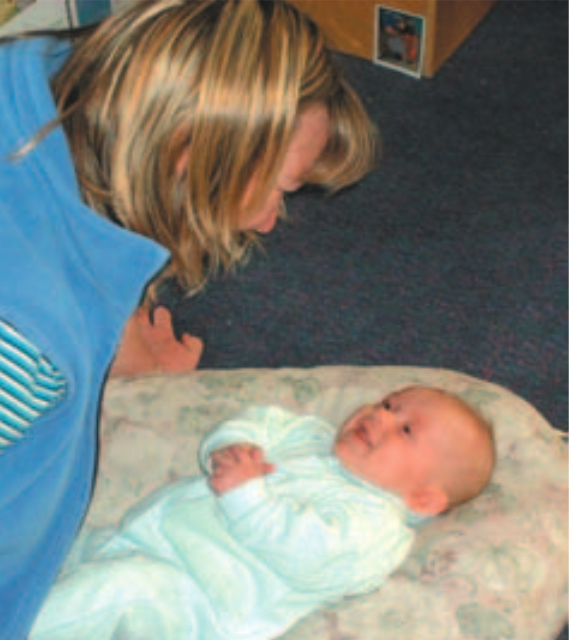
Parent's voice
22 November
Sam started going to the centre for three mornings a week when he was two months old. He pretty much knew only us. It was reassuring to us that Sam seemed to have got to know Justine in a couple of days, and now she is his favourite person at the centre. We really like it that Justine takes a genuine interest in Sam and his development and that she records all her observations in his daily diary and learning stories rather than just telling us about him each day. We really appreciate the learning stories and look forward to reading more of them! It’s a great record of what he’s up to while he’s there – something for us to look at and to show Sam’s whānau.
Sam has developed while at the centre, and it’s neat to see him interacting with the other adults and children. When he first started, he seemed to find it loud and would sleep a lot to block out the stimulus. Now, at four months old, he is much more aware of his surroundings and soaks everything in. He always has plenty to do at the centre and is very interested in everything around him during his awake times.
Since Sam is our first child, we didn’t have many expectations about child care beyond that Sam would be looked after while we weren’t there. But over the two months that Sam has been at the centre, we have been pleased to find that he is looked after by people who genuinely like him and want to participate in his development as much as we do.
They make an effort to see that he not only has his basic needs met but that he also has lots of learning opportunities, including talking and singing to him and giving him a variety of toys and activities.
Another aspect of the centre we like is that they facilitate our interactions with Sam during the day. Both of us are encouraged to come and visit him, and Hannah comes to breastfeed Sam twice during the day. (Sam is now at the centre three whole days a week.)
At home, Sam likes to play in bed with us in the morning, go for walks with us, watch his cat and dog, read stories (lots!), take a bath, and play with his toys (mostly with his tongue!). He enjoys relaxing and having a kick in his cot while watching and listening to his mobile. He especially enjoys this time in his room after a busy day at the centre. He likes to go out in the backyard and watch us hang out the washing, play with the dog, or work in the garden.
We feel that Sam is very settled and content in his time at the centre and that he likes going there. The routine that Sam has at the centre is pretty much the same as at home, and so his life is very smooth, with few disruptions. Through our efforts, and those of Justine and Ginny, Sam is a very contented child.
Predicting
28 November Teacher: Justine
Yesterday, when Sam woke, I went to his cot and opened it. Sam tracked the door of the cot sliding back. Once it was open, I quietly approached Sam, asking if he’d had a nice sleep. I stood for a few moments, rubbing his chest, and he was full of smiles and those slow, lazy movements of a waking child.
As I unwrapped him, I told him I was going to get him up. As I reached to put my hands under his body, he lifted his head. I didn’t think much of this until this morning when I was changing his nappy. Once again, I explained to him what I was doing, and as I reached under his body to lift him, he raised his head.
Interpretation/analysis
Sam is showing a lot more interest in the world around him. His ability to track a moving object is well developed. Once again, Sam responds to me with smiles, and this time he predicts what is about to happen to him.
I have always interacted with Sam in a calm, relaxed manner, explaining what is happening to him as I go. I believe this has enabled him to begin to take responsibility for his care and to predict familiar events that occur throughout his day. This demonstrates his developing sense of well-being within the centre and the sense of trust he has in me as his primary caregiver.
What next?
As I am on leave in a week, I will ask Ginny to take over some of Sam’s daily routines so that he becomes familiar with her while I am still around. Hannah has been coming over to feed him at 10 a.m. and 2 p.m., and I will encourage her to continue this while I am away so that there are not too many changes in Sam’s day.
Parent’s voice
Hannah informed me today that when they go into Sam’s room at home to get him up, they often find him grunting as he struggles to lift his head and upper body in anticipation of getting up. She also mentioned that he is beginning to assist them as they dress him by pushing his arm into his sleeves.
-
-
Michael: A helper, friend, and brother
-
Learning story
17 September Teacher: Gae
Michael’s mum says he really likes helping at home. He closes all the doors and enjoys helping adults to do tasks.
Michael helps me to get his bottle ready. He opens the fridge, gets his milk and gives it to me, shuts the microwave door, and pushes the buttons.
Short-term review
"Belonging, Goal 1: Children and their families experience an environment where connecting links with the family and the wider world are affirmed and extended."
Te Whàriki, page 56
Learning story
20 September
Teacher: Gae
Michael offered to help Matthew’s mum with Matthew’s lunchbox. He carried it over to the bench. Later, he wanted to help Sue get the nappy bucket, so off they went.
Short-term review
"Contribution, Goal 2: Children experience an environment where they are affirmed as individuals.
Children develop:
- awareness of their own special strengths [willingness to help], and confidence that these are recognised and valued."
Te Whàriki, page 68
Learning story
19 November
Teachers: Sue and Petra
Sue’s story
I was giving Michael a cuddle as he was having his bottle. As it was my lunch break, I talked to him, telling him that I was going to have my lunch and Petra would come and give him a cuddle while he finished his bottle.
He stayed relaxed as he went to Petra, and I told him I would see him when I got back from my lunch.
Petra’s story
I walked up to Sue and Michael and said, “I will give you a cuddle, Michael, because Sue is going to have some kai. She is hungry. You will see her when you wake up.”
Michael was very relaxed. He snuggled into my arms and was asleep within a minute.
Interpretation/analysis
Michael has found staffing changes during the day upsetting. However, he has formed strong relationships with two caregivers and is becoming more comfortable with staff transitions.
What next?
To continue to help Michael anticipate what will happen next during the day with verbal reassurance and cuddles.
To respect Michael’s choice of caregivers.
Sister’s voice
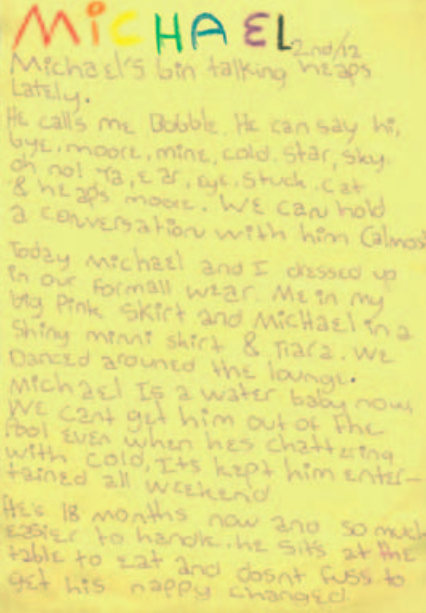
The present
16 May
Teacher: Gae
Skye gave Michael a car from home. She had waited a few days to give it to him as he was away sick. Sue gave him the car wrapped up and told him it was a present from Skye. He opened it out of the crinkly paper and really smiled, and he looked a bit shyly at Skye, who grinned back. They had lots of eye contact with each other. Michael started to play with the car up and down Sue’s arms and legs, and then he moved off by himself and played intently. He took the car home at the end of the day. He asked Sue if he could take the crinkly wrapping paper as well and went off happily.
Interpretation/analysis
A lovely social interaction, supported by Skye’s nanny, who brought the present in from home.
What next?
Michael and Skye’s relationship has been building over a period of time. We will continue to acknowledge and support this. Michael will soon be moving through to the pre-school. We will take Skye over for visits to see Michael and invite him into the nursery to spend time with Skye.
Michael making friends
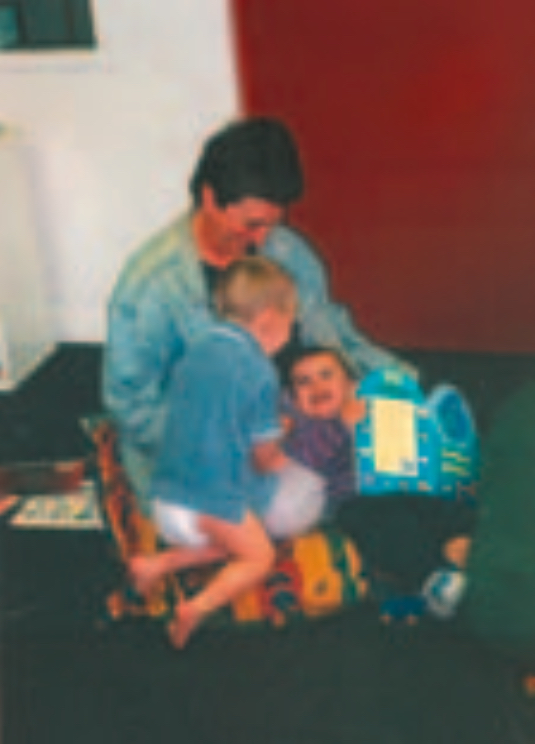
5 June
When Michael arrived this morning, he came over to Gemma and said, “Hello, Gemma.” Gemma smiled. Michael held both her hands and said, “Ringa, ringa, rosie.” Gae sang the song, and Gemma then climbed off her knee and went off to play.
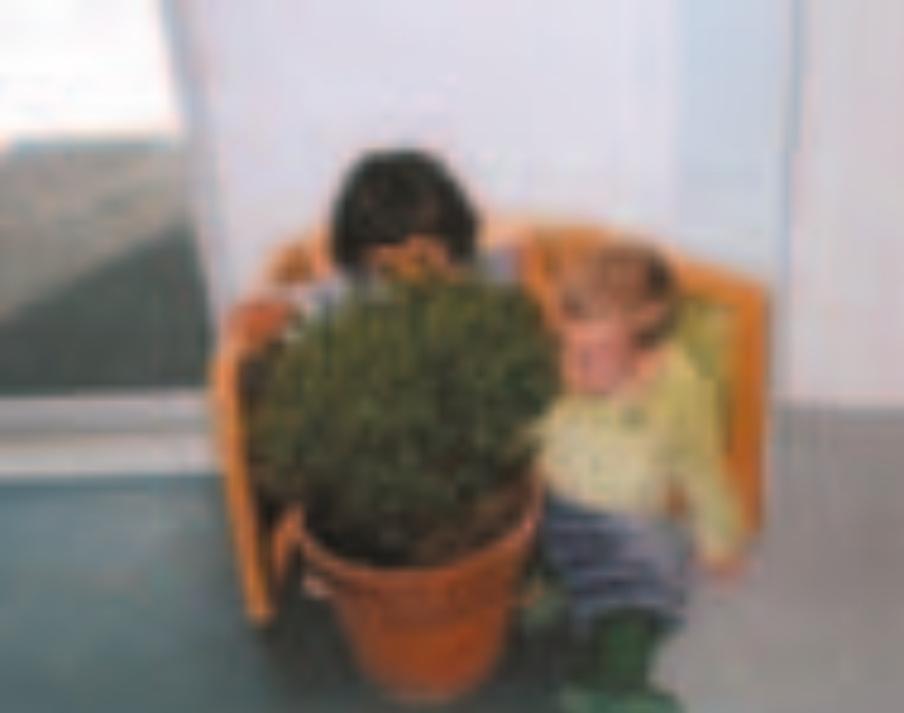
7 June
After kai, Skye sat in the middle of the mirror behind the pot plant. Michael looked at Skye before going over to join her. They sat there for a while, looking at the plant. Michael said, “Sue, I’m in the garden.” He said this several times. Michael and Skye laughed and smiled as they enjoyed each other and their situation.
11 June Teacher: Gae
I took Gemma and Skye through to the pre-school to visit Michael as these three had strong relationships in the nursery. Michael was sitting at the table. “Hi, Michael. I’ve brought Gemma and Skye to visit you.” He smiled broadly and opened his arms wide. We went over to him. Michael and Skye put their arms around each other, and Michael kissed Skye very gently on the cheek. We sat for a short while. Skye went outside. “Let’s go and play with the hammers with Skye, Michael.” “Yes!” So off we went. They hammered together, and then they played on the obstacle course together.
Next, they played with the blocks. Michael suggested the blocks were sushi. “Yum!” After twenty minutes, we all went in to the pre-school whānau time.
It was time for us to go back to the nursery for lunch. “Bye, Michael.”
Interpretation/analysis
Michael and Skye were obviously delighted to see each other. They played with and responded to each other in a positive way.
What next?
We will continue to support this relationship with regular visits to the pre-school and encourage and acknowledge their friendship.
-
-
Te Puawai: Mana reo
-
Communication is one of Te Puawai's strongest points. Te Puawai's language skills have increased significantly since the beginning of the year.
She supports her language using non-verbal communication methods such as facial expressions and hand gestures. Her verbal communication is based on fifty words or more, using one-to-three-word utterances like "Ka haere ia'', "He inu māku", or "Pānui pukapuka".
She knows everybody's names at kōhanga and can put names to faces. She has a very good understanding of what is asked of her, and she has the vocabulary to maintain short conversations in both Māori and English.
Reading is one of Te Puawai's favourite pastimes. You can usually find her sitting in the book room reading to herself, and she will follow a whaea into the room and pass her books to be read.
Her all-time favourites are the Pingipingi Pi collection by Jonathan Gunson and Marten Coombe and Spot i te Pamu by Eric Hill, which are read again and again every day. She particularly likes this book because it involves farm animals that she can identify by name, and she knows the sounds that each animal makes.
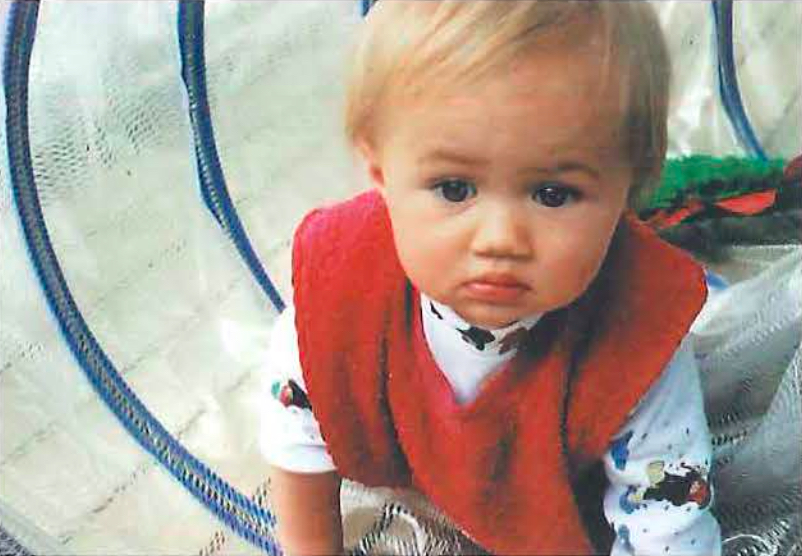
Observation
24 August
Te Puawai and I spent three-quarters of an hour looking through a National Geographic book. She became totally engrossed in this activity.
Links to Te whariki
Children enjoy returning to favourite books and recognising the distinctive characteristics of book language ...
(page 73)
Children gain an increasing ability to convey and receive information, instruction, and ideas effectively and confidently by listening, speaking, and using visual language in a range of contexts.
(page 97)
Strengths
Te Puawai can identify many objects, and she is able to pick up new kupu and symbols very quickly, sometimes relating an object (such as the spade) to an activity or place in which it is commonly used (such as the sandpit).
Needs identified
- Introduce new kupu to Te Puawai and get her to repeat them after us to help with pronunciation.
- Continue to kōrero to her as much as possible and encourage her to respond to us.
- Give her simple phrases to use at the table and during group play, such as:
- Hamai koa te ...
- Kua mutu ahau taku ...
- Ka taea e koe kl te...
- Continue to play games to use and reinforce new and old kupu that she has learned.
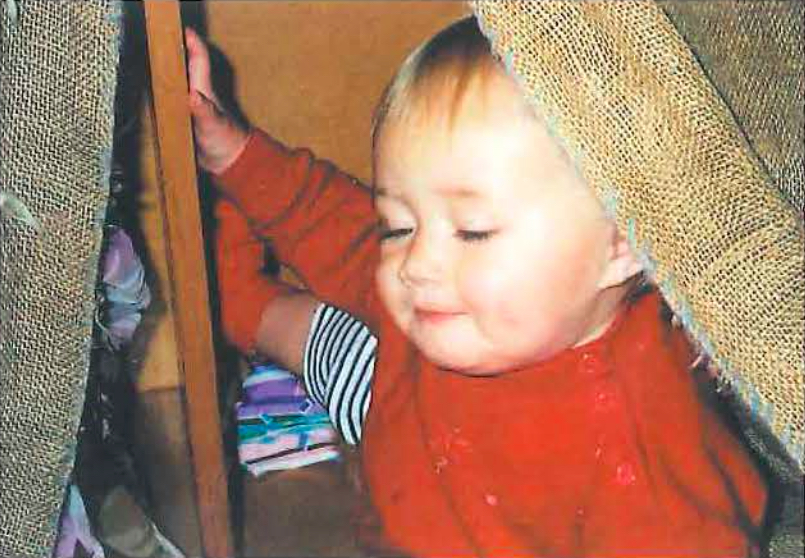
Language
Mana Reo - Communication
Tohenga Tuarua: Children experience an environment where they develop verbal communication skills for a range of purposes.
Te Puawai bas a good understanding of te reo. She uses a combination of simple phrases, directions, and commands. Recently, she has begun to 11 use more complex sentence structures, such as 'Ka taea e koe kite huakina'
- She can almost recite her whole pepeha right the way through, with only a small amount of assistance.
- She has a great imagination, matched by her great sense of humour.
- She often recites events from home, such as "Kei a Māmā Helen some toenails Whae pēra ki a au" or stories from the top of her head, such as the conversation we had about her going to kura.
Observation (Condensed version)
"Ka haere au lei te kura, Whaea Nero, mā runga motakā?" "Kāo, mā runga hōiho," she said, bouncing around the room as if she were on a horse. "Tino tere tōku hōiho." And, quick as a flash, putting her hand over her mouth, she said, "Auē, lwa taka taku hōiho i rota i te garden Whaea." Then she broke into fits of laughter as she proceeded to act out her story. I noted this observation, as I felt that it showed not only her level of Māori, but also her quick wit and ability to run.
- Te Puawai is also very descriptive. She likes to tell you what she is doing, sometimes in too much detail, such as when she is on the loo.
- She enjoys playing memory recall games. She recognises and names the pictures that she knows and will ask for the names of the pictures for those that she does not know.
- She was reading a pukapuka to Whaea Bernie almost word for word. When she wasn't sure of the word, she looked at the pictures. It's obviously a favourite, as she read it to Whaea Bernie four times and then came over and read it to me. (The book is Te Wahi Pai by Manu Te Awa.)
- She has a good understanding of our routines. She informed one of our manuhiii that they still had their "!m's" on, and then told me, "Kei te hē te wahine, Whaea kei mau hū ia, aye”."
- We have found that when Te Puawai begins to speak in Māori, she will finish the whole sentence in Māori and not revert to English!!
-
